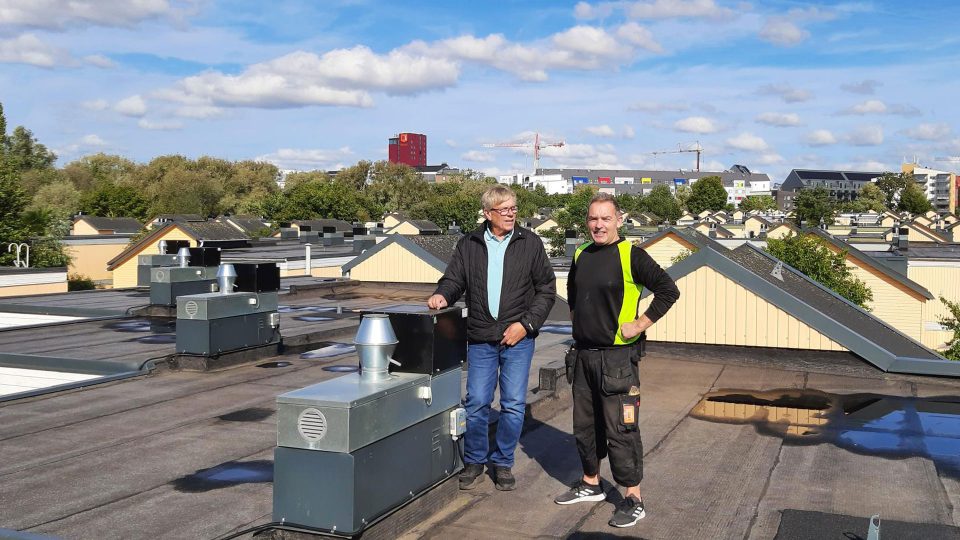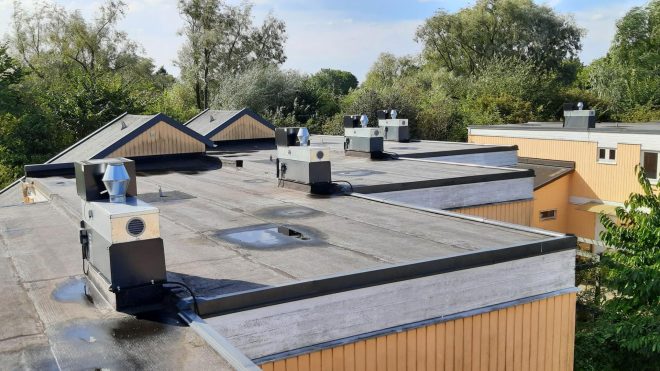When “Djingis Khan” – a residential complex in the southern Swedish city of Lund – was planned, the criteria were clear: it aimed to create living quarters in a pleasant atmosphere with room for social and cultural exchanges. And things had to be done quickly, as there was a lot of demand among students. In a short space of time, the prefabricated modules resulted in 316 two-floor lodges, grouped by 20 individually designed farms. In 1981 “Djingis Khan” was transformed into a residential housing association within HSB, a cooperative company focused on facility management. Today, many families with children live in “Djingis Khan”: living in a green space in close proximity to the city makes this particularly attractive for them.

A good indoor climate was required
However, the requirements for ventilating houses have also changed in recent years. Self or joint ventilation used to be implemented. The pressure difference between the inside and outside automatically ensures a certain amount of air exchange, but it was not satisfactory. Aiming to improve the ventilation and thus the climate inside the buildings, the people in charge discussed installing a mechanical ventilation system back in the 1990s.
“We wanted energy-efficient, quiet fans. That’s why the choice fell on EC fans from ebm-papst.”Anders Nilsson
Additional insulation has also been applied and energy-saving improvements have been made to the crawl spaces. In 2017, HSB finally equipped ten apartments with systems for mechanical exhaust air and pressure-controlled ventilation. AC fans were initially used. However, these required additional noise insulation because the noise level was too high.
EC a must!
Nilsson supervised the process over the years. He is the owner of VFS Ventservice in Lund and is responsible for planning and implementing the ventilation system for “Djingis Khan”.

Nilsson recalls, “When we carried out the tests with the AC fans, the focus was exclusively on improving the ventilation system. But since then, there is also greater demand for energy efficiency and fans that are as quiet as possible.”In a nutshell, AC fans are too loud for today’s standards and consume too much electricity.
Nilsson researched alternatives and found what he was looking for: “When ebm-papst developed its new series of sound-insulated roof fans with an energy-efficient EC motor and a temperature and pressure control option, the decision was easy,” he says. The people in charge at HSB were also impressed by the new technology and Nilsson got started with the detailed planning.
Together with ebm-papst sales engineer Jan Sörensen, he set about selecting the components. They chose the MXRC22R roof fan model. Sörensen explains, “We develop and produce the MXRC series here in Sweden. It satisfies all the requirements currently being placed on roof fans: The sound insulation ensures a low noise level, and they have high efficiency levels and integrated control electronics. What’s more, they are energy efficient.”
Light fans are used on the roofs of “Djingis Khan”. They weigh 13 kilograms, have an output of 85 watts and reach a free-air flow rate of 936 m3/h. The MXRC22R fans are delivered with a control system with Modbus RTU. This enables a wide range of programming options for effective and demand-based ventilation.
Assembly made easy
Sörensen reiterates, “The fans make work much easier for installers. For example, the control connection is housed in a separate box on the inside of the fan housing. What’s more, the roof fans have a folding floor frame that stabilizes the fan during installation.”

For Anders Nilsson, this is an important issue. After all, he was the one to install the 316 fans. For him as a small businessman, it was a Herculean task, which he set himself alone – in close cooperation with an electrical technician and a construction company.
WHAT THE TECH?! Is an EC motor more energy efficient than an AC motor?

What is the difference between AC and EC motor? Find out here:
Nilsson smiles and recalls, “That was the biggest project ever for me. I completed the work in autumn 2021, but I started it a few years before. We decided to install 100 fans per year, and I had the option of planning the work during the summer months, which of course was a major advantage. This is because installing roof fans in winter can be difficult!” The ebm-papst fans being easy to assemble ensured smooth operation and everything went as planned.
The residents of the estate and the housing association are also satisfied with Nilsson’s work. They are particularly pleased that the fans have a low noise level and that their homes have reliable ventilation. Thanks to their higher efficiency and intelligent control, the fans consume less power. They are set for a need-based ventilation that saves energy, since they reduce the flow to the needed level. Overall, the “Djingis Kahn” residential estate achieves energy savings of 30 percent per year compared to the previous installation using AC fans. All those involved agree that this retrofit has paid off.
Discover more:
Energy-efficient ventilation technology for industry & commerce
Whether centrifugal or axial fans, bathroom ventilation systems, AHU systems, facade ventilation and in roof fans.


Leave a comment